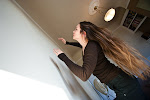Aged four or five I sneaked into the walk-in closet in my maternal grandparent’s house. Really a narrow and deep storage room it housed seasonal clothing currently not in use, piles of folded sheets, boxes with linen handkerchiefs (some with vintage cartoon prints), long forgotten fur hats, silk gowns last worn a quarter century earlier. I think I was told not to go there, but I went anyway. I was very quiet and made sure not to make a mess.
Center of the floor there was a hatch atop an earth cellar. I had no intention of going THERE. I had been warned against it, but that was really not necessary. The cellar was a dark and murky place, chilly and small. You had to hold an electric torch to find the right jam, bottle of sherry, or the bag of potatoes you needed. I had often seen my Grandma open the hatch, then lean it against the wall while she climbed down the ladder a few rungs. She directed the flashlight with the other hand. She was always fast. (She is always fast, whatever she does.) Ostensibly I had to keep an eye on the hatch so it wouldn’t bang close. Probably she appreciated the company, the connection to other people while down in the cellar.
The most magical thing in this secret room was a ball of yarn that my Grandma had around that time. She had a broad, shallow basket where she kept her yarn and mending needles. (She never knit.) I crept under the hanging winter coats and saw the basket. And there was a round, perfect thing of unidentified nature. I took it out and brought it to light for inspection. I had never seen anything simultaneously so vibrant and so unreal. It was wool, but I had never seen the color before. It seemed to radiate, to suck the now grey environment into its own universe. There was plenty that looked familiar, but unmistakably it was not that familiar thing. It wasn’t blue. And it was not green. I found it breathtakingly beautiful.
Recognizing familiar in something new and strange is uncanny. I later asked my parents about it. It was dark turquoise. They found it nothing special.
No colour combination has ever sucked me into beauty the way green and blue juxtaposed does. You’d think that’s everywhere in the nature. Maybe that’s why.
There used to be a whole theoretical construction in Western art criticism that defined shape and line as rational or related to concept, to the male principe. Colour was irrational, emotional, physical, feminine. Of course, the idea of intellect, emotion and somatics being separate entities or forces in humans has turned out to be an illusion - as is the division between feminine and masculine. Understanding the uncanny of a colour entails acknowledging the conceptual nature of our perception of it.
Laura Arrington has been working with the colour teal lately. She clothes dancers in teal leather pants. She covers guitars, megaphones and large areas of fabric in teal sequins. She paints everything else she gets her hands at, teal. For me no other color like that to mark the remove from everyday. The shade of teal she has chosen is flat. Not the deep, vibrant turquoise of my childhood, but the blunt, opaque teal of inexpensive man-made materials.
Facing something unrecognizable while acknowledging its familiarity is uncanny.
Apart from choice of shade, the strategy Arrington employs here is excess. Everything must be painted same colour. You don’t much see that in the wild. Objects are not decorated with a few sequins just so here and there, they are doused in sequins. The actresses don’t just let their tears roll down, they SCREAM and trash around on the ground shooting with fire arms. This excess swells inside a spectator from unknown sources opening the places I did not know I encompassed.


